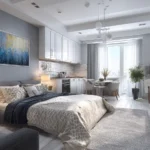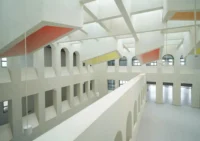Situated in the quiet village of Sleman, Yogyakarta—just a short walk from a local private university—Porous Habitat is a 12-unit boarding house designed to offer more than simple accommodation. This project addresses the growing demand for student housing in Yogyakarta while embracing the character and rhythm of its village surroundings.

Architectural Inspiration and Contextual Form
The architectural concept takes cues from the limasan, a traditional pitched-roof structure prevalent across the area. Rather than directly replicating the form, Inklusi.dsg reinterprets it into a clean, contemporary volume that respects tradition without resorting to imitation. This sensitive adaptation allows the building to integrate quietly into its environment. The chosen materials are raw, monolithic, and understated—ensuring the structure blends into the surrounding streetscape rather than dominating it.
This subtlety is central to the project’s ethos. The term “porous” in the building’s name goes beyond its physical permeability. It reflects an openness to light, air, and the social and cultural environment of the village. The ground floor remains grounded—both in physical structure and in social interaction—while the upper level opens to the sky, inviting daylight and natural breezes. Together, both levels maintain a connection to the stillness, sense of community, and welcoming warmth that defines life in the area.
Social and Cultural Sensitivity
Yogyakarta is a city renowned for its academic atmosphere, drawing students from all over Indonesia. Living in such a place often means navigating the balance between being part of a new community and respecting local customs. Porous Habitat is designed to foster that balance, encouraging residents to feel both welcomed and mindful. This approach nurtures a quiet confidence—supporting personal growth, learning, and adaptation in a setting away from home.

Spatial Layout and Village-Like Ground Floor
The design of the communal ground floor takes direct inspiration from rural village layouts. Paths and open areas are not just circulation spaces—they are places for interaction. The parking area is paved with plastic grass pavers, which allow grass and local gravel to grow through, softening the appearance of hard surfaces while maintaining functionality.
A shared kitchen and dining area sit shaded beneath existing trees, creating a cool and comfortable spot for residents to prepare meals, eat together, and unwind. This shaded communal hub reduces stress, encourages healthy interaction, and becomes a focal point for daily life.
Light, Air, and Micro-Interactions
Natural lighting is carefully integrated throughout the building. Corridors are illuminated via 15 cm-wide skylights concealed within gypsum cove ceilings, providing ample daylight without overheating the interior spaces. The light is diffused and comfortable, fostering a sense of safety and openness.
In front of each unit, a small transition space acts as an in-between zone—neither fully private nor entirely public. This space, separated from the corridor by rain strings, becomes a small personal threshold where residents can leave shoes, place stools, or engage in brief conversations with neighbors. These subtle design gestures encourage casual social encounters, slowly building a sense of togetherness and security.

Private Units and Ventilation Strategy
Each of the 12 rooms, ranging from 9 to 12 m², is designed with two openings to enable cross-ventilation. This ensures that fresh air and natural light can circulate freely without compromising privacy. These rooms, though compact, are thoughtfully planned to feel comfortable and efficient for daily living.
The building’s structure employs a closed portal concrete system with 4.5-meter spans. This choice not only minimizes beam size and reduces construction costs but also creates narrow gaps between units. These gaps play a crucial role in improving natural airflow, enhancing the overall porosity of the design.
Furniture and Cultural Adaptation
Furnishings are tailored to local living habits, with arrangements that accommodate floor seating for studying—an approach that is familiar, comfortable, and culturally resonant. The interiors avoid excess decoration, instead focusing on durability, practicality, and comfort.

Living in the Rhythm of the Village
Porous Habitat is not simply a student boarding house. It is a carefully designed environment that supports both individual and communal well-being. Through its architectural form, material selection, and spatial planning, it invites residents to participate in the slow, restorative pace of village life.
This project redefines the idea of student accommodation—not as an isolated, purely functional space, but as an active participant in its context. It respects tradition while offering contemporary comfort, fosters independence while encouraging community, and allows students to live, learn, and grow in harmony with their surroundings.
Photography: Ukara Studio
- Communal living spaces
- compact living solutions
- Concrete portal frame construction
- Contextual architecture Indonesia
- Cross-ventilated student rooms
- Cultural sensitivity in design
- Indonesian contemporary architecture
- Inklusi.dsg architecture
- Limasan roof reinterpretation
- Passive ventilation strategies
- Plastic grass paver landscaping
- Porous Habitat Yogyakarta
- Raw material architecture
- Skylight corridor design
- Sleman student housing
- Socially responsive design
- Student accommodation design
- Sustainable boarding house design
- Village-inspired architecture
- Yogyakarta architecture projects











































Leave a comment